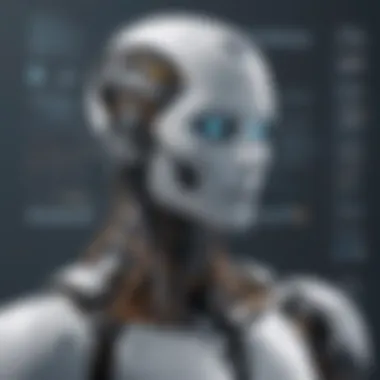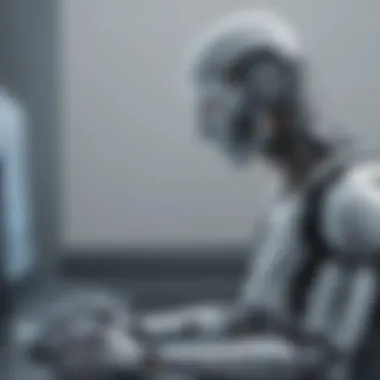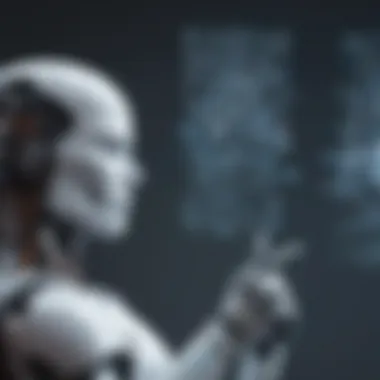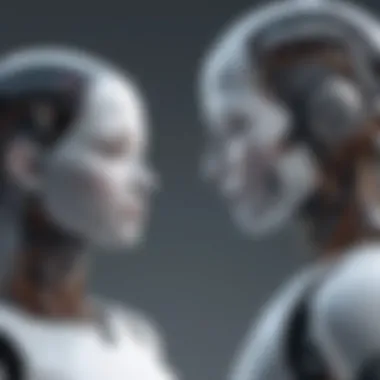Unveiling the Intricate Human-Robot Relationship in Tech


Tech Trend Analysis
Overview of the Current Trend
The intersection of humans and robots in the tech realm unveils a fascinating landscape of evolving interaction. As technology advances, the roles of humans and robots continue to intertwine, shaping the future of innovation and automation. Understanding this trend is paramount for tech enthusiasts and industry professionals seeking to grasp the implications of this symbiotic relationship.
Implications for Consumers
Consumers today are increasingly encountering robots in various aspects of their lives, from personal assistants to automated manufacturing processes. This shift poses both opportunities and challenges, such as enhanced efficiency and potential job displacement. Navigating these implications requires a nuanced understanding of how humans and robots collaborate in different settings and industries.
Future Predictions and Possibilities
Looking ahead, the future holds exciting prospects for the integration of humans and robots in diverse sectors like healthcare, transportation, and even entertainment. Predictions indicate a surge in robotic assistance and autonomous technologies, revolutionizing the way we live and work. Anticipating these possibilities is crucial for staying abreast of the evolving tech landscape.
Product Reviews
Overview of the Product
Features and Specifications
Delving deeper, each product boasts unique features and specifications that cater to specific needs and preferences. Whether it's voice recognition, facial recognition, or autonomous navigation, these technologies empower users with unprecedented functionality and convenience.
Performance Analysis
Assessing the performance of human-robot interaction tools is essential to gauge their effectiveness and usability. Factors such as speed, accuracy, and adaptability play a crucial role in determining the overall performance of these products in real-world scenarios.
Pros and Cons
While the benefits of incorporating robots into daily operations are evident, there are also drawbacks to consider. Issues related to data security, privacy concerns, and potential malfunctions underscore the importance of a balanced analysis of the pros and cons of these technologies.
Recommendation
For consumers and businesses exploring human-robot collaboration, making an informed decision is key. Evaluating the features, performance, and overall value proposition of these products helps in selecting solutions that align with specific requirements and objectives.
How-To Guides


Introduction to the Topic
Embarking on the journey of exploring the relationship between humans and robots necessitates an understanding of the fundamental concepts and principles underpinning this dynamic interaction. Building a solid foundation in this field sets the stage for exploring advanced applications and techniques.
Step-by-Step Instructions
Navigating the complexities of human-robot interaction demands a systematic approach. From setting up robotic systems to programming them for specific tasks, following step-by-step instructions ensures a seamless integration of human intelligence with robotic capabilities.
Tips and Tricks
Enhancing the efficiency and effectiveness of human-robot collaboration involves uncovering valuable tips and tricks. Strategies for optimizing communication, streamlining workflows, and troubleshooting common challenges empower users to harness the full potential of this synergy.
Troubleshooting
In the realm of human-robot interaction, encountering technical glitches and challenges is inevitable. Having a troubleshooting guide at hand equips users with the knowledge and skills to address issues promptly, ensuring minimal downtime and maximizing productivity.
Industry Updates
Recent Developments in the Tech Industry
As technology continues to evolve at a rapid pace, the tech industry witnesses a flurry of groundbreaking developments in the realm of human-robot interaction. From advancements in AI algorithms to the integration of robotics in new domains, staying informed about these updates is essential for industry professionals.
Analysis of Market Trends
Analyzing the trends shaping the market for human-robot collaboration provides valuable insights into consumer preferences, technological advancements, and competitive landscapes. Understanding these trends enables businesses to adapt their strategies and offerings to meet evolving demands.
Impact on Businesses and Consumers
The convergence of humans and robots has far-reaching implications for both businesses and consumers. Enterprises leveraging robotic technologies can enhance productivity and streamline operations, while consumers benefit from innovative solutions that cater to their evolving needs. Examining the impact of this convergence is instrumental in navigating the changing tech landscape.
Introduction
The topic of humans and robots in the tech world is a captivating subject that has garnered widespread attention in recent years. As technology continues to advance at a rapid pace, the interactions between humans and robots are becoming increasingly intricate and impactful. This article seeks to dissect the nuanced dynamics at play, shedding light on the evolving roles of both humans and robots, and delving into the far-reaching implications for the future of tech innovation.
Defining Humans and Robots
When we talk about humans and robots, it is essential to understand the distinct characteristics that define each entity. Humans, with their cognitive abilities, emotional depth, and adaptability, have long been the drivers of innovation and progress. On the other hand, robots, designed with artificial intelligence, sensors, and actuators, serve as tools programmed to perform specific tasks autonomously or under human guidance. This section aims to outline the fundamental differences between humans and robots, setting the stage for a deeper exploration of their evolving relationship.


Evolution of Robotics
The evolution of robotics has been a fascinating journey marked by significant milestones and technological breakthroughs. From early mechanical automata to modern-day humanoid robots and AI-powered machines, the field of robotics has witnessed remarkable advancements. Through a chronological narrative, this section will trace the evolution of robotics, highlighting key innovations, scientific discoveries, and the convergence of technology that have shaped the present landscape of human-robot interactions.
Purpose of the Article
In crafting this article, the primary aim is to unravel the complexities surrounding the relationship between humans and robots in the tech world. By dissecting key concepts, exploring emerging trends, and analyzing the societal impact of robotics, this article endeavors to provide readers with a detailed roadmap of this dynamic landscape. Furthermore, the article aims to stimulate critical thinking and provoke discussions on the ethical, social, and technological implications of human-robot collaboration in shaping the future of technology.
Understanding Human-Robot Interaction
In the intricate world of technology, the essence of Understanding Human-Robot Interaction cannot be overstated. This article magnifies the pivotal role played by this interaction, shedding light on the nuances that shape the dynamic relationship between humans and robots. Delving into the depths of this interaction provides profound insights into how both entities collaborate, coexist, and influence each other within the tech landscape.
Collaborative Efforts
Within the realm of human-robot interaction, collaborative efforts stand as the cornerstone of progress and innovation. It is through collaborative initiatives that humans and robots synergize their strengths, working towards common goals and driving technological advancements. The seamless integration of human intelligence with robotic capabilities leads to enhanced problem-solving, creativity, and efficiency, heralding a new era of technological possibilities.
Challenges Faced
Despite the promising prospects that human-robot interaction offers, numerous challenges loom on the horizon. Issues such as technological limitations, safety concerns, and ethical dilemmas pose significant hurdles in the path of seamless collaboration between humans and robots. Overcoming these challenges demands meticulous planning, robust system design, and a deep understanding of the implications of integrating robots into various facets of human life.
Ethical Considerations
As humans and robots converge in the tech domain, ethical considerations emerge as a critical focal point. The ethical implications of human-robot interaction encompass a wide array of complex scenarios, ranging from privacy concerns to the ethical use of AI. Establishing guidelines for ethical conduct, ensuring data security, and promoting transparency in algorithmic decision-making are imperative to cultivating a harmonious coexistence between humans and robots in the ever-evolving tech landscape.
Impact of Robotics on Society
In the context of this article on exploring the relationship between humans and robots in the tech domain, delving into the impact of robotics on society is of paramount importance. Society's adaptation to the advancements in robotics influences various facets of our daily lives. One key aspect to consider is the job market dynamics – the potential job displacement caused by automation. As robotics and AI continue to progress, there arises a valid concern regarding the displacement of human workers by automated systems.
This transition towards automation not only affects industry operations but also resonates in societal structures. The debate on the necessity of upskilling the workforce to align with technological progress or invest in other sectors gains prominence. The intricacies of this impact extend beyond mere job losses to the very fabric of societal norms and economic structures. Understanding and addressing these concerns are crucial steps in navigating the evolving landscape driven by technological advancements.
Job Displacement Concerns
The section on job displacement concerns within the impact of robotics on society necessitates a closer examination of the challenges posed by automation. With the integration of robotic systems in various industries, there comes a significant shift in the employment landscape. Job roles traditionally performed by humans are gradually being taken over by automated processes.
This shift underscores the importance of reevaluating skill sets and fostering adaptability among workers to thrive in a tech-driven environment. Addressing these displacement concerns requires strategic planning and proactive measures to mitigate the potential repercussions on unemployment rates and economic stability. By identifying key areas prone to job displacement and strategizing suitable interventions, stakeholders can navigate through this transition effectively.


Enhanced Efficiency in Industries
Enhancing efficiency in industries through the integration of robotics represents a transformative shift in operational dynamics. With the advent of AI-powered robots and automation technologies, industries witness a streamlining of processes and a boost in productivity levels. Automation in manufacturing settings, for instance, leads to optimized production workflows and reduced manual errors.
This enhanced efficiency not only accelerates production cycles but also paves the way for innovations in product quality and precision. By leveraging robotics for repetitive tasks and complex operations, industries can allocate human resources to strategic roles that require critical thinking and creativity. The efficiency gains facilitated by robotics streamline operations, driving competitive advantage and fostering sustainable growth in a technologically evolving landscape.
Social Integration Challenges
The section addressing social integration challenges in the context of robotics' impact on society sheds light on the intricacies of harmonizing technological advancements with societal structures. As robotics permeates various sectors, including healthcare, manufacturing, and beyond, adapting to these changes poses social integration challenges. Ensuring inclusive participation and equitable access to technological benefits emerge as primary objectives.
Social integration challenges extend beyond mere technological adoption to encompass ethical considerations and societal implications. Balancing technological progression with inclusivity and diversity becomes essential in fostering a cohesive societal framework. By initiating dialogues around the ethical use of robotics, promoting equitable access, and addressing potential disparities, society can navigate the complexities of integrating technological advancements while upholding fundamental human values.
Current Trends in Human-Robot Collaboration
When delving into the realm of technology and its relationship with humans and robots, understanding the current trends in human-robot collaboration becomes paramount. This section sheds light on the significance of these trends within the larger context of technological advancements. Human-robot collaboration is at the forefront of innovation, revolutionizing industries and daily life. By exploring specific elements of this collaboration, such as advancements in robotics, artificial intelligence, and automation, readers gain insights into the benefits and considerations associated with these trends. The integration of robots into various sectors like healthcare, manufacturing, and space exploration has redefined processes, increasing efficiency, accuracy, and safety. Understanding and adapting to these current trends is crucial for individuals keen on staying abreast of the ever-evolving tech landscape.
Robotics in Healthcare
The application of robotics in healthcare, specifically assistive robotics and surgical robotics, has transformed the medical field. Assistive robotics, with its focus on aiding individuals in their daily activities and medical needs, offers a unique blend of mobility assistance and therapeutic support. These robots incorporate cutting-edge technology to empower patients and healthcare providers alike. In contrast, surgical robotics streamline complex surgical procedures, enhancing precision and reducing recovery times. Their key characteristic lies in their ability to perform intricate tasks with unparalleled accuracy, minimizing human error and improving patient outcomes. While the advantages of assistive robotics revolve around enhancing quality of life and independence, surgical robotics excel in reducing invasiveness and promoting quicker recovery. However, challenges such as initial costs and training requirements remain considerations in adopting these technologies.
Automation in Manufacturing
The integration of AI-powered robots and supply chain automation in manufacturing processes has revolutionized production workflows. AI-powered robots leverage machine learning algorithms to boost productivity, accuracy, and safety on factory floors. Their key characteristic lies in their adaptability to dynamic environments, enabling seamless collaboration with human workers. Supply chain automation optimizes logistics and inventory management, streamlining operations and minimizing errors. Its key advantage lies in enhancing supply chain efficiency and responsiveness to market demands. However, the limitations of AI-powered robots in handling nuanced tasks and the potential risks of supply chain disruptions underscore the need for a balanced approach to automation in manufacturing.
Robots in Space Exploration
The utilization of robots in space exploration, exemplified by rovers on Mars and ISS robotics, marks a significant milestone in technological achievements. Rovers on Mars are equipped with advanced sensors and instruments to conduct scientific experiments and gather crucial data about the Martian surface. Their key characteristic is their ability to navigate rugged terrains autonomously, expanding our understanding of planetary environments. ISS robotics play a crucial role in maintenance and repair tasks aboard the International Space Station. These robotics excel in executing delicate operations in microgravity conditions, enhancing the station's functionality. The advantages of rovers on Mars lie in their capacity for long-duration missions and remote exploration. Conversely, ISS robotics offer unparalleled dexterity and precision in handling intricate tasks in space. However, challenges such as communication delays and limited mobility pose constraints on the effectiveness of these robotic systems in space.
Future Prospects and Speculations
In this segment focusing on the Future Prospects and Speculations in the tech domain, we dissect the critical aspects that shape the trajectory of human-robot interaction. This section elucidates the importance of forecasting and speculating on the future of AI and Robotics, shedding light on the innovative pathways these advancements pave. By exploring the potential advancements awaiting us, we gain invaluable insights into the evolving landscape of technology.
Advancements in AI and Robotics
At the core of Future Prospects lies the realm of Advancements in AI and Robotics. This section navigates through the cutting-edge innovations in Artificial Intelligence and Robotics, deciphering their impact on the symbiotic relationship between humans and machines. Delving into the nuances of machine learning, neural networks, and advanced robotics, we unravel the revolutionary breakthroughs driving tech evolution.
Implications on Employment
With technology advancing at a rapid pace, the Implications on Employment stand as a pivotal point of discussion. This segment unravels the intricate web linking job markets and technological advancements, analyzing the impact on various industries and employment sectors. By probing into the challenges and opportunities arising from automation and AI integration, we paint a cogent picture of the future employment landscape.
Human-Robot Coexistence
The concept of Human-Robot Coexistence transcends mere collaboration, embodying a symbiotic relationship poised to redefine societal structures. This section delves into the ethical, social, and philosophical dimensions of coexisting with intelligent machines, envisioning a future where human and robot seamlessly interact and complement each other. By exploring the intricacies of mutual understanding and respect between humans and robots, we pave the way for a harmonious technological future.



